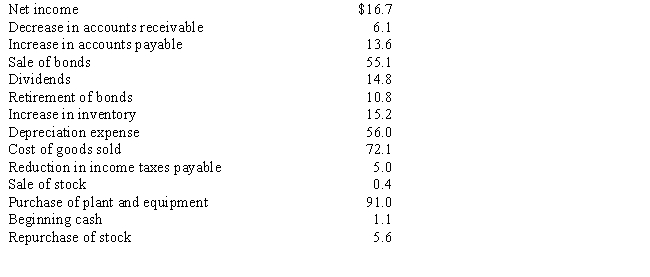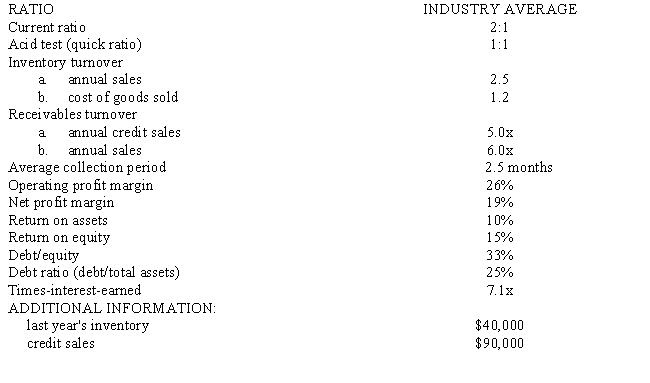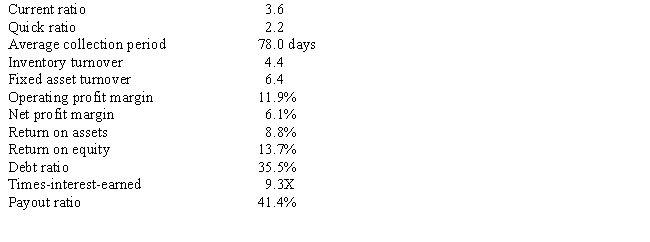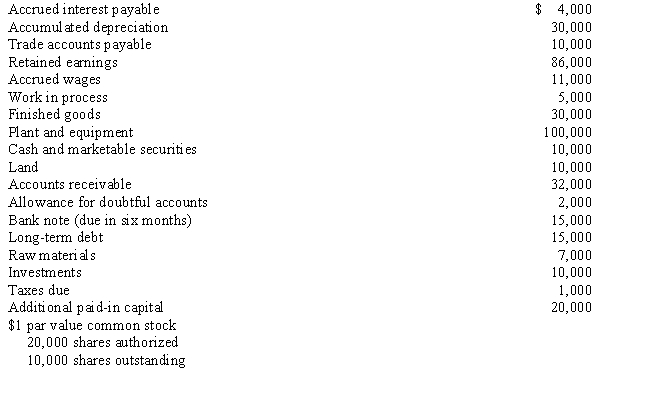Deck 13: Analysis of Financial Statements
Question
Question
Question
Question
Question
Question
Question
Question
Question
Question
Question
Question
Question
Question
Question
Question
Question
Question
Question
Question
Question
Question
Question
Question
Question
Question
Question
Question
Question
Question
Question
Question
Question
Question
Question
Question
Question
Question
Question
Question
Question
Question
Question
Question
Question
Question
Question
Question
Question
Question
Question
Question
Question
Question
Question

Unlock Deck
Sign up to unlock the cards in this deck!
Unlock Deck
Unlock Deck
1/55
Play
Full screen (f)
Deck 13: Analysis of Financial Statements
1
If the firm's current ratio exceeds 1:1 and the firm retires an account payable,the quick ratio increases.
True
2
The return on equity measures earnings before interest and taxes.
False
3
If accounts receivable are collected more rapidly,the average collection period is reduced.
True
4
An inventory turnover of 3.0 suggests that inventory is sold every four months.

Unlock Deck
Unlock for access to all 55 flashcards in this deck.
Unlock Deck
k this deck
5
The current ratio and the quick ratio are measures of asset usage.

Unlock Deck
Unlock for access to all 55 flashcards in this deck.
Unlock Deck
k this deck
6
The quick ratio excludes inventory,plant,and equipment.

Unlock Deck
Unlock for access to all 55 flashcards in this deck.
Unlock Deck
k this deck
7
The greater the numerical value of the debt ratio,the riskier the firm.

Unlock Deck
Unlock for access to all 55 flashcards in this deck.
Unlock Deck
k this deck
8
If inventory is sold for cash instead of on credit,inventory turnover is increased.

Unlock Deck
Unlock for access to all 55 flashcards in this deck.
Unlock Deck
k this deck
9
If a firm's inventory turnover is 4.0 and receivables turnover is 6.0,then it takes about five months for newly acquired inventory to generate cash.

Unlock Deck
Unlock for access to all 55 flashcards in this deck.
Unlock Deck
k this deck
10
Senior debt should have a lower times-interest-earned than junior debt.

Unlock Deck
Unlock for access to all 55 flashcards in this deck.
Unlock Deck
k this deck
11
The proportion of a firm's assets that are financed by debt is measured by the debt ratio.

Unlock Deck
Unlock for access to all 55 flashcards in this deck.
Unlock Deck
k this deck
12
If accounts receivable are collected,the quick ratio is unaffected.

Unlock Deck
Unlock for access to all 55 flashcards in this deck.
Unlock Deck
k this deck
13
Coverage ratios may be used to measure the safety of debt and other fixed obligations.

Unlock Deck
Unlock for access to all 55 flashcards in this deck.
Unlock Deck
k this deck
14
The return on assets employs operating income instead of net income.

Unlock Deck
Unlock for access to all 55 flashcards in this deck.
Unlock Deck
k this deck
15
An increase in retained earnings will increase the debt to equity ratio.

Unlock Deck
Unlock for access to all 55 flashcards in this deck.
Unlock Deck
k this deck
16
Ratios may be used in both time-series and cross-section types of analysis.

Unlock Deck
Unlock for access to all 55 flashcards in this deck.
Unlock Deck
k this deck
17
An increase in assets financed by equity increases the debt ratio.

Unlock Deck
Unlock for access to all 55 flashcards in this deck.
Unlock Deck
k this deck
18
Net profit margins on sales tend to exceed operating profit margins on sales.

Unlock Deck
Unlock for access to all 55 flashcards in this deck.
Unlock Deck
k this deck
19
A times-interest-earned of 0.9 means that interest will not be paid.

Unlock Deck
Unlock for access to all 55 flashcards in this deck.
Unlock Deck
k this deck
20
The quick ratio is a better measure of liquidity than the current ratio for manufacturers.

Unlock Deck
Unlock for access to all 55 flashcards in this deck.
Unlock Deck
k this deck
21
When a firm makes a profitable sale,its total assets increase.

Unlock Deck
Unlock for access to all 55 flashcards in this deck.
Unlock Deck
k this deck
22
Cash flow depends on depreciation as well as the firm's earnings.

Unlock Deck
Unlock for access to all 55 flashcards in this deck.
Unlock Deck
k this deck
23
If the ratio of debt to equity increases,the proportion of assets financed by debt is increased.

Unlock Deck
Unlock for access to all 55 flashcards in this deck.
Unlock Deck
k this deck
24
The current ratio is unaffected by
A) using cash to retire an account payable
B) the collection of an account receivable
C) selling inventory for a profit
D) selling bonds and using the funds to finance inventory
A) using cash to retire an account payable
B) the collection of an account receivable
C) selling inventory for a profit
D) selling bonds and using the funds to finance inventory

Unlock Deck
Unlock for access to all 55 flashcards in this deck.
Unlock Deck
k this deck
25
Firms with too much debt are undercapitalized.

Unlock Deck
Unlock for access to all 55 flashcards in this deck.
Unlock Deck
k this deck
26
As the debt ratio increases,
1)fewer assets are debt financed
2)more assets are debt financed
3)the ratio of debt to equity increases
4)the ratio of debt to equity decreases
A) 1 and 3
B) 1 and 4
C) 2 and 3
D) 2 and 4
1)fewer assets are debt financed
2)more assets are debt financed
3)the ratio of debt to equity increases
4)the ratio of debt to equity decreases
A) 1 and 3
B) 1 and 4
C) 2 and 3
D) 2 and 4

Unlock Deck
Unlock for access to all 55 flashcards in this deck.
Unlock Deck
k this deck
27
Coverage ratios measure a firm's
A) ability to use debt financing
B) use of plant and equipment
C) ability to cover (i.e., sell) its inventory
D) ability to meet fixed payments such as interest
A) ability to use debt financing
B) use of plant and equipment
C) ability to cover (i.e., sell) its inventory
D) ability to meet fixed payments such as interest

Unlock Deck
Unlock for access to all 55 flashcards in this deck.
Unlock Deck
k this deck
28
The comparability of the individual investor's ratio computations with industry averages is reduced by the age of industry averages.

Unlock Deck
Unlock for access to all 55 flashcards in this deck.
Unlock Deck
k this deck
29
The net profit margin increases as the firm's interest expense declines.

Unlock Deck
Unlock for access to all 55 flashcards in this deck.
Unlock Deck
k this deck
30
The quick ratio
A) excludes accounts payable
B) excludes accounts receivable
C) includes inventory
D) includes cash and cash equivalents
A) excludes accounts payable
B) excludes accounts receivable
C) includes inventory
D) includes cash and cash equivalents

Unlock Deck
Unlock for access to all 55 flashcards in this deck.
Unlock Deck
k this deck
31
As times-interest-earned increases,
A) bondholders' position deteriorates
B) net income decreases
C) interest payments become more assured
D) taxes decrease
A) bondholders' position deteriorates
B) net income decreases
C) interest payments become more assured
D) taxes decrease

Unlock Deck
Unlock for access to all 55 flashcards in this deck.
Unlock Deck
k this deck
32
Activity ratios measure
A) how rapidly assets flow through the firm
B) how frequently the firm's stock is traded
C) how rapidly employees turn over
D) the profitableness of accounts receivable
A) how rapidly assets flow through the firm
B) how frequently the firm's stock is traded
C) how rapidly employees turn over
D) the profitableness of accounts receivable

Unlock Deck
Unlock for access to all 55 flashcards in this deck.
Unlock Deck
k this deck
33
Lower cash flow may be the result of higher depreciation expense.

Unlock Deck
Unlock for access to all 55 flashcards in this deck.
Unlock Deck
k this deck
34
The more financially leveraged a firm,the smaller is its debt ratio.

Unlock Deck
Unlock for access to all 55 flashcards in this deck.
Unlock Deck
k this deck
35
The average collection period measures
A) the speed with which accounts payable are paid
B) the speed with which accounts receivable are collected
C) the safety of accounts receivable
D) the safety of accounts payable
A) the speed with which accounts payable are paid
B) the speed with which accounts receivable are collected
C) the safety of accounts receivable
D) the safety of accounts payable

Unlock Deck
Unlock for access to all 55 flashcards in this deck.
Unlock Deck
k this deck
36
The statement of cash flow places emphasis on management's ability to retire debt.

Unlock Deck
Unlock for access to all 55 flashcards in this deck.
Unlock Deck
k this deck
37
Bondholders are concerned with the firm's operating income,while stockholders are concerned with its net income.

Unlock Deck
Unlock for access to all 55 flashcards in this deck.
Unlock Deck
k this deck
38
Lower depreciation increases earnings and cash flow.

Unlock Deck
Unlock for access to all 55 flashcards in this deck.
Unlock Deck
k this deck
39
Inventory turnover may increase if
A) the firm increases its accounts payable
B) the firm uses less debt financing
C) the firm increases its inventory
D) the firm lowers the prices of its goods
A) the firm increases its accounts payable
B) the firm uses less debt financing
C) the firm increases its inventory
D) the firm lowers the prices of its goods

Unlock Deck
Unlock for access to all 55 flashcards in this deck.
Unlock Deck
k this deck
40
Stockholders who seek capital gains prefer a large payout ratio.

Unlock Deck
Unlock for access to all 55 flashcards in this deck.
Unlock Deck
k this deck
41
Given the following information,construct the statement of cash flows.What happened to the firm's liquidity position during the year?



Unlock Deck
Unlock for access to all 55 flashcards in this deck.
Unlock Deck
k this deck
42
Using the income statement and balance sheet constructed in (1)and (2),compute the following ratios.Compare the results with the industry averages.What strengths and weaknesses are apparent?



Unlock Deck
Unlock for access to all 55 flashcards in this deck.
Unlock Deck
k this deck
43
Determine a firm's earnings per share from the following information.



Unlock Deck
Unlock for access to all 55 flashcards in this deck.
Unlock Deck
k this deck
44
Which of the following has no impact on cash flow?
A) the firm's equity
B) depreciation expense
C) taxes paid
D) net income
A) the firm's equity
B) depreciation expense
C) taxes paid
D) net income

Unlock Deck
Unlock for access to all 55 flashcards in this deck.
Unlock Deck
k this deck
45
Creditors would prefer
1)a quick ratio of 1.2 to a quick ratio of 0.8
2)a quick ratio of 0.8 to a quick ratio of 1.2
3)an average collection period of 46 to an average collection period of 35
4)an average collection period of 35 to an average collection period of 46
A) 1 and 3
B) 1 and 4
C) 2 and 3
D) 2 and 4
1)a quick ratio of 1.2 to a quick ratio of 0.8
2)a quick ratio of 0.8 to a quick ratio of 1.2
3)an average collection period of 46 to an average collection period of 35
4)an average collection period of 35 to an average collection period of 46
A) 1 and 3
B) 1 and 4
C) 2 and 3
D) 2 and 4

Unlock Deck
Unlock for access to all 55 flashcards in this deck.
Unlock Deck
k this deck
46
An analysis of last year's financial statements produced the following results.
 Use the following data to compute the comparable financial ratios for next fiscal year.Has the firm's financial position changed?
Use the following data to compute the comparable financial ratios for next fiscal year.Has the firm's financial position changed?

 Use the following data to compute the comparable financial ratios for next fiscal year.Has the firm's financial position changed?
Use the following data to compute the comparable financial ratios for next fiscal year.Has the firm's financial position changed?

Unlock Deck
Unlock for access to all 55 flashcards in this deck.
Unlock Deck
k this deck
47
Operating income is not affected by
A) depreciation
B) cost of goods sold
C) rent payments
D) interest earned
A) depreciation
B) cost of goods sold
C) rent payments
D) interest earned

Unlock Deck
Unlock for access to all 55 flashcards in this deck.
Unlock Deck
k this deck
48
Owners of bonds would prefer
1)a debt ratio of 60 percent to a debt ratio of 40 percent
2)a debt ratio of 40 percent to a debt ratio of 60 percent
3)a times-interest-earned of 5.1 to a times-interest-earned of 3.9
4)a times-interest-earned of 3.9 to a times-interest-earned of 5.1
A) 1 and 3
B) 1 and 4
C) 2 and 3
D) 2 and 4
1)a debt ratio of 60 percent to a debt ratio of 40 percent
2)a debt ratio of 40 percent to a debt ratio of 60 percent
3)a times-interest-earned of 5.1 to a times-interest-earned of 3.9
4)a times-interest-earned of 3.9 to a times-interest-earned of 5.1
A) 1 and 3
B) 1 and 4
C) 2 and 3
D) 2 and 4

Unlock Deck
Unlock for access to all 55 flashcards in this deck.
Unlock Deck
k this deck
49
Efficient financial markets suggest that
A) fundamental analysis leads to superior returns
B) fundamental analysis does not lead to superior returns
C) ratio analysis predicts changes in stock prices
D) ratio analysis reduces market efficiency
A) fundamental analysis leads to superior returns
B) fundamental analysis does not lead to superior returns
C) ratio analysis predicts changes in stock prices
D) ratio analysis reduces market efficiency

Unlock Deck
Unlock for access to all 55 flashcards in this deck.
Unlock Deck
k this deck
50
Which of the following is a cash inflow?
A) distributing a stock dividend
B) retiring an account payable
C) collecting an account receivable
D) paying property taxes
A) distributing a stock dividend
B) retiring an account payable
C) collecting an account receivable
D) paying property taxes

Unlock Deck
Unlock for access to all 55 flashcards in this deck.
Unlock Deck
k this deck
51
Construct a balance sheet from the following information.



Unlock Deck
Unlock for access to all 55 flashcards in this deck.
Unlock Deck
k this deck
52
The return on equity
A) is the ratio of sales to equity
B) measures what the firm earns on assets
C) is the ratio of net income to total equity
D) measures what the firm earns on sales
A) is the ratio of sales to equity
B) measures what the firm earns on assets
C) is the ratio of net income to total equity
D) measures what the firm earns on sales

Unlock Deck
Unlock for access to all 55 flashcards in this deck.
Unlock Deck
k this deck
53
Which of the following is a cash outflow?
A) splitting the stock two for one
B) acquiring inventory
C) retaining earnings
D) switching from straight-line depreciation to accelerated depreciation
A) splitting the stock two for one
B) acquiring inventory
C) retaining earnings
D) switching from straight-line depreciation to accelerated depreciation

Unlock Deck
Unlock for access to all 55 flashcards in this deck.
Unlock Deck
k this deck
54
Cash flow differs from earnings because
A) cash flow includes depreciation expense
B) earnings can be negative
C) taxes only affect earnings
D) interest expense only affects cash flow
A) cash flow includes depreciation expense
B) earnings can be negative
C) taxes only affect earnings
D) interest expense only affects cash flow

Unlock Deck
Unlock for access to all 55 flashcards in this deck.
Unlock Deck
k this deck
55
The debt ratio is a measure of
1)financial leverage
2)the use of debt financing
3)asset utilization
A) 1 and 2
B) 1 and 3
C) 2 and 3
D) all of these choices
1)financial leverage
2)the use of debt financing
3)asset utilization
A) 1 and 2
B) 1 and 3
C) 2 and 3
D) all of these choices

Unlock Deck
Unlock for access to all 55 flashcards in this deck.
Unlock Deck
k this deck



